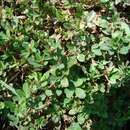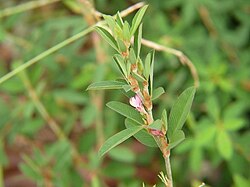fr
noms dans le fil d’Ariane


Kummerowia striata is a species of flowering plant in the legume family known by the common names Japanese clover and common lespedeza.[1][2] It is native to much of Asia and it is present in the eastern United States as an introduced species.[3]
This annual herb grows prostrate, spreading, or erect stems. It grows up to 40 centimeters tall. The leaves are made up of three oval leaflets. Flowers occur in the leaf axils. There are cleistogamous flowers, which self-fertilize and never open, and chasmogamous flowers, which open and receive pollen from other plants.[4] The fruit is a small legume pod containing one seed.[4]
At the close of the American Civil War, this plant appeared all over the southern United States.[5] It was likely introduced to North America accidentally, possibly as a seed contaminant, but it was later imported and planted intentionally. It was used to vegetate pastures and provide forage for livestock. Along with Korean clover it was used to revegetate abandoned coal mine sites and to prevent erosion, as it thrives in sandy soils that have been disturbed by human activity. It is still used today. Cultivars are available, including "Kobe".[6]
It has benefits to human health and agriculture, as well as providing a food source to numerous species across the food web. Nevertheless, this plant is sometimes invasive.[4]
Kummerowia striata can grow to be 16 inches (410 mm) tall.[7] Leaves grow alternate from one another, and only grow to be 0.75 inches (19 mm) long.[7][8] The leaf edges have no teeth or lobes.[9] The tops of the leaves are dark green, and the bottom of the leaf is light green.[8] The plant grows 0.2–0.3 inches (5.1–7.6 mm) long flowers in three different colors, pink, purple, and white.[7] Flowers sprout from leaf axils in clusters of 1–3.[8] The petals and sepals are fused at the base to form a cup like structure.[9] K. striata has both male and female parts and can either self-pollinate or be pollinated by insects.[2] Each flower has five petals and a light green calyx with five teeth.[8] The plant has two types of flowers, one has colored petals and the other has no petals.[6] K. striata blooms for approximately two months (August to September), from the summer into the fall.[8][2] In the following two months (October to November) the seeds ripen.[2] The fruits are 0.2 inches (5.1 mm) long and each contain one seed.[7] The fruit is dry and stays intact when ripe.[9] The plant is an annual, but re-seed prolifically.[8]
Kummerowia striata (Thunb. ) Schindl.[10] was formerly classified as Lespedeza striata.[1][11] Its common names include Japanese clover and common lespedeza.[1][2] Kummerowia striata is in a genus with one other species, Kummerowia stipulacea.[12] They are both herbaceous legumes and can be differentiated by their calyx coverings.[12] The calyx of K. stipulacea covers 1/3 to 1/2 of the legume, whereas K. striata′s calyx covers 1/2 to 4/5 of the legume.[12]
Kummerowia striata is native to China, and Japan.[13] The plant is invasive to North American, and it is distributed along the east coast from New York to Florida.[13] It reaches as far west as New Mexico.[13] It was first noticed in Charleston, Virginia in the 1840s.[9] Kummerowia striata is most likely to be found in fields, woods, on the side of roads, or other areas where the ground may have been disturbed.[1][9][2] It is uncommon to find a single Kummerowia striata, it is more likely to find a group of them.[2] Kummerowia striata will grow best in moist sandy soil with direct sunlight, but can still grow in other conditions.[8][2] Kummerowia striata can grow in the 4.5–7.0 pH range, but thrives at 6.0–6.5.[6]
Kummerowia striata is used in traditional Chinese medicine as an anti-inflammatory.[14] The plant promotes blood circulation, removes heat, and detoxes blood. It has been historically used to treat dysentery, sores, abscesses, and to stop diarrhea, among other ailments.[14][2] The plant can also be used to treat fever, headache, vertigo, and loss of appetite.[2]
Kummerowia striata is a natural nitrogen fixer, meaning it fixes atmospheric nitrogen out of the air and converts it to plant available nitrogen. Nitrogen is released into the soil when the plant dies. Kummerowia striata can also be used for erosion control.[6]
If planting for Nitrogen enrichment, pair the legume with bunch type grasses.[6] Do not pair with any sod like grasses, they out compete K. striata.[6] Although the plant re-seeds itself, when being used as a source for grazing it must be reseeded manually to keep the plant numbers high enough to provide adequate food for grazers.[6][8] The best time to plant K. striata is mid spring.[2] When planting K. striata the seed should be soaked in warm water for 12 hours before the seed is planted.[2]
Kummerowia striata is a food source for numerous species across the food chain from pollinators to herbivores.[8][6] Most of the pollination is done by bees and they are the only ones who leave the plant intact after they visit. Species of caterpillars, beetles, and moths all eat the leafy parts of this plant at some point in their life stages.[8] The seeds of K. striata are consumed by the Prairie Deer Mouse, gamebirds, and songbirds.[8] Deer, and other herbivores also munch on this plant, choosing to eat the leaves and other foliage.[8]
Kummerowia striata has also been used by farmers for grazing.[6] Grazing or cutting K. striata should occur when the plant is in the half bloom stage, and it is best to leave the bottom three inches of the plant intact.[6] The legume is useful for grazing because of its bloom time, it is in bloom from summer to fall, and is an alternative to the grazing grasses that are only available in the cooler months.[6]
Kummerowia striata is also edible to humans, although it only ranks a two out of five on edibility, based on one scale of edibility.[2] The leaves and seeds of the plant are edible when cooked.[2] The seeds can also be turned into meal and used in baking.[2]
Kummerowia striata is a species of flowering plant in the legume family known by the common names Japanese clover and common lespedeza. It is native to much of Asia and it is present in the eastern United States as an introduced species.
This annual herb grows prostrate, spreading, or erect stems. It grows up to 40 centimeters tall. The leaves are made up of three oval leaflets. Flowers occur in the leaf axils. There are cleistogamous flowers, which self-fertilize and never open, and chasmogamous flowers, which open and receive pollen from other plants. The fruit is a small legume pod containing one seed.
At the close of the American Civil War, this plant appeared all over the southern United States. It was likely introduced to North America accidentally, possibly as a seed contaminant, but it was later imported and planted intentionally. It was used to vegetate pastures and provide forage for livestock. Along with Korean clover it was used to revegetate abandoned coal mine sites and to prevent erosion, as it thrives in sandy soils that have been disturbed by human activity. It is still used today. Cultivars are available, including "Kobe".
It has benefits to human health and agriculture, as well as providing a food source to numerous species across the food web. Nevertheless, this plant is sometimes invasive.
Kummerowia striata là một loài thực vật có hoa trong họ Đậu. Loài này được (Thunb.) Schindl. miêu tả khoa học đầu tiên.[1]
Kummerowia striata là một loài thực vật có hoa trong họ Đậu. Loài này được (Thunb.) Schindl. miêu tả khoa học đầu tiên.
鸡眼草(学名:Kummerowia striata)是一种豆科植物。
一年生草本,多分枝,小枝上有向下倒挂的白色细毛。复叶互生,具3小叶;有短柄;长椭圆形或倒卵状长椭圆形的小叶,先端圆形,其中脉延伸呈小刺尖,基部楔形;沿中脉及边缘有白色鬃毛。长卵形托叶较大,急尖。
1~2朵蝶形花,腋生;小苞片4,卵状披针形;深紫色钟状花萼,长2.5~3毫米,5裂,裂片阔卵形;浅玫瑰色花冠,较萼长2~3倍,旗瓣近圆形,顶端微凹。
卵状矩圆形荚果,有短细毛,萼宿存。黑色种子1粒,具不规则的褐色斑点。花期7~9月,果期9~10月。
在中国主要分布于东北、华东、华中和华北、西北、西南、中南各省区;此外,主要分布日本、朝鲜、苏联远东地区,越南及北美洲也有。[1]
鸡眼草(学名:Kummerowia striata)是一种豆科植物。
 分類 界 : 植物界 Plantae 門 : 被子植物門 Magnoliophyta 綱 : 双子葉植物綱 Magnoliopsida 亜綱 : バラ亜綱 Rosidae 目 : マメ目 Fabales 科 : マメ科 Fabaceae 属 : ハギ属 Lespedeza 種 : ヤハズソウ L. striata 学名 Lespedeza striata
分類 界 : 植物界 Plantae 門 : 被子植物門 Magnoliophyta 綱 : 双子葉植物綱 Magnoliopsida 亜綱 : バラ亜綱 Rosidae 目 : マメ目 Fabales 科 : マメ科 Fabaceae 属 : ハギ属 Lespedeza 種 : ヤハズソウ L. striata 学名 Lespedeza striataヤハズソウ(Lespedeza striata (Thunb.) Hook. et Arn.)は、マメ科ハギ属の雑草。葉を引っ張ると矢筈形に千切れることから、この和名がついた。
小型の一年草である。背丈は20-50cm、茎は根元で分枝して立ち上がるか、地表をやや斜めに伸びて次第に立ち、先端は斜め上に伸びるようになる。茎は細いが硬くて節があり、節ごとに葉が出る。また、下向きの毛がはえている。托葉は卵形で淡褐色。
葉は三出複葉、小葉はだ円形で先端は丸く、頂小葉がやや大きい。葉はつやのない緑色で葉質は草質。特徴的なのが葉脈で、側脈が多数あって、それらはほぼ平行して斜めに出て、いずれもほぼ直線的に葉の縁にまで達する。光に透かせると、それらが明るく浮かんで、矢筈状の模様に見える。
花は7-9月、葉腋につき、単独か最大6個くらいまでまとまって出る。花の長さは5mm程と小さく、赤みを帯びた紫色。果実は種子一個を含む節果で、円形で偏平。
和名は漢字で矢筈草とする。これは、上述のように葉脈が矢筈状に見え、これを引きちぎると矢筈型に切れることに由来する。
日当たりのよい草地、川原などに生える。雑草として道端に出ることもよくある。やや湿った場所によく出現する。
北海道から琉球列島に分布し、国外では中国、台湾、朝鮮から知られる。
ハギ属に含めるが、羽状複葉でなく、羽軸がない掌状複葉である等の差異があるため、特にヤハズソウ属 (Kummerowia) を立てる扱いもある。日本でこれに含まれるものとして、以下の種がある。
小柄な雑草である。特に繁茂するものでもない。茎が丈夫で踏み付けに強いためか、未舗装道路に繁茂しているのをよく見る。
利益となることもないが、子供の遊びとして、葉先をつまんで引っ張ると、必ず側脈で切れるので、矢筈状の切れ端ができるのを見て喜ぶ、というのがある。
また永井荷風は、この植物を題材にした随筆「矢はずぐさ」を執筆した。その中で永井は、妻の八重次がヤハズソウを煎じて薬草として服用している様子を描いている[1]。
매듭풀은 한국·중국·일본 등지에 분포하는 한해살이풀로 높이 10-30cm 정도이다. 줄기는 곧게 서며 가늘고 길다. 가지는 많이 갈라지며 잔 털이 나고, 잎은 어긋나며 잎자루가 짧고 3개의 작은 잎으로 구성되며 작은 잎은 긴 거꿀달걀 모양이다. 꽃은 연한 홍색으로 8-9월에 잎겨드랑이에서 1-2개씩 피고, 꽃자루는 짧으며 꽃턱잎은 5-7개의 맥(脈)이 있다. 수술은 10개이고 암술대는 실모양이며 꽃받침은 짧은 털이 있으며 5개로 갈라진다. 열매는 협과로 둥글며 1개의 씨가 들어 있다. 햇빛이 잘 드는 길가나 풀밭에서 자란다.